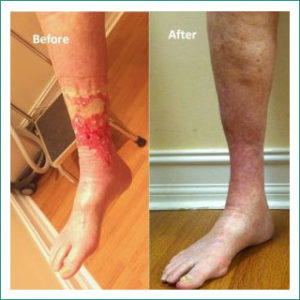Venous Ulcer Treatment
 Many issues with leg veins result from a general condition called venous insufficiency. Venous insufficiency occurs when the veins in your legs aren’t circulating blood back to the heart efficiently. When this happens, fluids can pool in the leg, and a number of problems can arise. Some of the more painful problems caused by venous insufficiency are venous ulcers.
Many issues with leg veins result from a general condition called venous insufficiency. Venous insufficiency occurs when the veins in your legs aren’t circulating blood back to the heart efficiently. When this happens, fluids can pool in the leg, and a number of problems can arise. Some of the more painful problems caused by venous insufficiency are venous ulcers.
Table of Contents
ToggleVenous ulcers present as wounds or sores on the skin of the leg, usually the skin around the ankle. Conventional treatments for leg ulcers focus on healing the external skin only and fail to address any underlying issues with the veins. This is why up to 90% of venous ulcers recur in the 12 months following such treatments. A far more effective option is Laser Vein Treatment, also known as endovenous ablation.
How Does Endovenous Work?
“Endovenous” is a medical term meaning “from within the vein.” Endovenous laser ablation refers to the process of closing veins from the inside with blasts of highly focused light from a laser. During treatment, a small laser fiber is inserted into the problem vein, and the application of the laser causes the vein to close on its own. The problem veins are then harmlessly absorbed into the body. After the vein is removed, the blood that was trying to circulate through it will now re-route to more robust veins deep in the leg. Best of all, when treated with this specialized laser vein treatment, 12-month recurrence rates for ulcers drop to 10%.
How Long Is Endovenous Treatment?
Treatments typically take one hour.
What Can I Expect After Endovenous Treatment?
Downtime is minimal, with patients able to return to normal activities the next day, and results appear soon after that.









